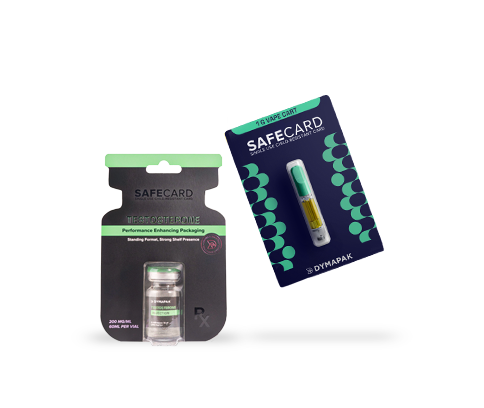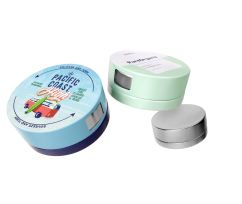Sustainable Packaging Options for Consumer Goods
There are a myriad of sustainable packaging options for consumer businesses. For instance, beauty brand Cocokind uses materials such as ocean waste plastic and sugarcane tubes in its packaging. It also includes detailed recycling guidelines for the products.
The company is additionally educating its consumers on the impact these green efforts have on the planet with sustainability statistics and more on their social media and blog.
There are hundreds of other companies adopting sustainability practices and green initiatives — and if you’re looking to learn more, you’re not alone. Let’s learn more about specific options and their impact on business and the environment.
How Can I Make My Company More Sustainable?
Businesses have learned during the pandemic how profitable remote work is. Even more so is how sustainable it is.
Because employees are not commuting to a physical working space, fewer vehicles are on the road, and there is less idling in traffic, which means less carbon dioxide is emitted into the atmosphere. Also, the energy that could have been used to heat, cool, or light the office is saved.
About 12.1 trillion sheets of paper are used by US businesses annually. That’s a lot of trees. Therefore, businesses can be more sustainable by moving their paperwork online to reduce paper waste, save trees, and create more storage.
Recycling Packages
Cardboard is one of the easiest materials to recycle. The corrugated cardboard base is built of high-value grade paper, making it durable. Therefore, it’s suitable for reuse in the packaging industry. In truth, it was the most recycled paper in 2015 at 92.9%.
Wood packaging protects items in the food, chemical, and automotive industries. This eco-friendly material is recyclable into paper and reusable into boards, mulch, or animal bedding.
On the other hand, bubble wrap has been created from the same plastic that makes dry-cleaning and grocery bags. Before recycling, it will be popped to create a sheet of plastic. It will then be ground into plastic pellets used for making other plastic products.
You can also recycle metal scrap, glass, plastic bottles, aluminum, and rubber to extend their life cycle.
Reducing Product to Package Ratio
Larger packages use more materials to make and take up more space during transit, requiring more vehicles to transport, consuming more fuel. That’s why it’s important to use automated systems for choosing the right package size based on product characteristics.
You can also hire experts to analyze your products and determine the smallest size possible to safeguard your items. This helps control shipping costs and environmental impact as well.
What Are Some Sustainable Packaging Options?
1. Cellulose Packaging
Cellulose packaging is created from natural sources such as cotton, wood, and hemp. Since the material is compostable and biodegradable, it is sustainable.
This sustainable packaging solution is resistant to moisture, making it an ideal pick for food brands.
2. Corrugated Bubble Wrap
Bubble wraps are generally used to safeguard shipped items, but they’re not environmentally friendly. They can, however, be made green by using up-cycled corrugated cardboard.
Small cuts are made in the cardboard to form a concertina effect that safeguards goods against shock.
3. Cornstarch Packaging
Cornstarch material is derived from corn plants and has plastic-like characteristics. It’s ideal for replacing petroleum-based plastic packaging in the long term as it’s biodegradable.
However, it results in less food for humans and animals, making it necessary to consider the pros and cons before use.
4. Mushroom Packaging
Clean agricultural waste is fused with mushroom roots to create mushroom packaging. The manufacturer can create any packaging shape.
The material is highly compostable and avoids the use of petroleum during production, making it sustainable.
5. Recycled and Eco-Friendly Plastics
Some items are bulky and require stronger materials like plastics. So, you can use recycled plastics in this case to ensure the integrity of your merchandise.
6. Recycled Cardboard and Paper
Cardboard boxes are great since they make shipping more sustainable and less cumbersome. When harnessed, paper and cardboard boxes are easy to recycle and reduce waste pollution in the environment.
Polyethylene: Why It’s the Best Choice for Sustainable Packaging
Polyethylene is a great sustainable material as you can recycle it. Recycling reduces the need for fossil fuels required to manufacture new material, saving energy and cost.
Moreover, polyethylene recycling decreases the negative environmental impact and costs linked to the disposal of plastic wastes. Disposing plastics in the open air and land releases toxic substances into the air, which can contribute to public health problems.
Polyethylene packaging is lightweight, allowing for shipping of more products and consumption of less fuel. This means there are reduced emissions of greenhouse gasses, and fewer fossil fuels are used.
Polyethylene Is Recyclable
It’s straightforward to recycle polyethylene as long as it hasn’t been combined with other plastics, forming composite materials. It’s normally recycled with the same function, which means old canisters are recycled into new ones, and an old film is recycled into a new one.
Polyethylene products are numerous, including shampoo bottles, detergent containers, and tetra packs, all of which end up together before the recycling process due to a lack of a returns system in most countries. Therefore, modern systems assist in detecting and sorting plastic types, shapes, colors, and foreign things.
A 99% rejection accuracy means that the highest purity level is achieved. Innovative camera and lighting technologies detect difficult-to-distinguish items and colors.
Choose Polyethylene Bags from a Company Committed to Sustainability
At Dymapak, we put sustainable packaging and best practices at the forefront of your business because that’s our business. Sustainable packaging, recyclable packaging and plastic alternatives like PLA and PHA are important to your brand’s image because today’s consumer wants to buy from businesses that care about the environment.
Cost is a big part of business operations, and sustainable packaging can help you cut your costs. Money is saved in shipping expenses and storage costs because polyethylene bags are compact and can be moved and stored in large numbers. Moreover, the federal government provides tax savings, rebates, and credits to businesses that go green.
Partner with us for your green, child-resistant packaging and stand to gain everything and lose nothing.
Why Choose Sustainable Packaging?
1. Lowers Your Carbon Footprint
Consumers care about how they impact the environment, which directly affects the brands and products they are loyal to. Using eco-friendly packaging ensures you fulfill your corporate social responsibility.
When you put the eco-friendly packaging process top of mind, you can reduce your brand’s carbon footprints.
Your carbon footprint is the amount of carbon dioxide emitted into the atmosphere during fossil fuel consumption. Opting for reusable and recyclable items as well as reducing packaging can help lower a company’s carbon footprint.
Also, consider changing to lightweight packaging since it consumes less energy during manufacture and transit.
2. Creates More Storage Space
Sustainable packaging creates more transport and storage space, allowing you to move more goods and incur less shipping and storage costs.
Moreover, you’ll have more shelf space, which lets you get creative with the display.
3. Sustainable Packaging Can Be Allergen and Toxin Free
Consumers want to buy from companies that support their health and will not buy from those with allergens and toxins in their packaging.
Therefore, consider investing in biodegradable packaging or reusable packaging that doesn’t affect the well-being and health of your consumers.
4. Increases Brand Revenue
Because being an environmentally conscious brand is attractive to the current consumer market, reducing your carbon footprint will attract more buyers for your products and increase your revenue.
5. Sustainable Packaging is Versatile
Eco-friendly packaging is not restricted to the frequency of use by the manufacturer and can be reused and repurposed in major industries where conventional packaging is used.
What’s more, you can work more forms and designs with your green packaging.
6. It Boosts the Brand Image
People want to positively impact the environment without making a significant change in their lives. Hence, if you provide a wide range of green packaging, consumers will happily buy from you since you provide an easy way to accomplish something they care about.
Consequently, this will boost your brand image.
How Are Recyclable Materials Better for the Planet?
1. Protects Wildlife and Ecosystems
Recycling entails a decreased need to grow, harvest, and take raw materials from the earth. Fewer rivers are diverted, forests cut down, and wild animals displaced or harmed. There’s also less air, soil, and water pollution.
2. Conserves Natural Resources
The earth’s natural resources are limited. For instance, ancient woodlands or virgin forests can’t be replaced once lost. Hence, recycling wood and paper saves forests and trees.
The manufacture of plastic uses energy from fossil fuels. So, recycling plastics means fewer new plastics are produced, more focus is placed on renewable energy, and less fossil fuel is used.
In the same spirit, recycling metals means fewer metal ores will be mined, and glass recycling means less use of materials like sand.
3. Decreases Demand for Raw Materials
The high demand for natural resources has led to the displacement of vulnerable people as companies seek to encroach forests and rivers for raw materials. Therefore, it’s commonplace to have evicted forest communities and polluted rivers in a society where there’s dependence on raw materials for manufacturing and production.
Recycling is good for the environment, as there’s less need for raw materials.
4. Saves Energy
When products are not made new, plenty of energy is saved during the production process. For instance, manufacturing new aluminum from recycled foil and cans uses 95% less energy than fresh raw materials. In the case of steel, 70% of energy is saved.
Producing paper using pulped recycled paper uses 40% less energy than virgin wood fibers.
5. Saves Cost of Waste Collection
Did you know that it’s six times cheaper to get rid of recycled waste than general refuse? Hence, the more people recycle, the more money consumers, businesses, and local governments. You can recycle food waste to create compost manure for growing more food and other valuable plants.
6. Reduces Carbon Emissions
Recycling results in less manufacturing of new material, which leads to lower carbon emissions. It also means that waste that releases methane doesn’t end up in landfills.
As a result, this curbs climate change.
How Do Non-Sustainable Plastics Contribute to Climate Change?
Extraction and Manufacturing
The origin of plastics is fossil fuels; the plastic industry uses about 6% of all oil in the world, likely reaching 20% by 2050. The extraction and distillation process of oil and the manufacture of plastics are energy-intensive and result in massive amounts of greenhouse gasses.
End of Life
When plastic is not disposed of or recycled properly, it generates greenhouse emissions when exposed to the sun in water and air. About 18 million tons of plastics coming from South Asia end up in oceans where they emit ethylene and methane after exposure to sunlight.
In fact, each minute, a garbage truck of plastics is dumped into the ocean. These plastics break down into microplastics, which, when ingested by planktons, reduce the planktons’ ability to get rid of carbon dioxide from the atmosphere.
Open Burning
About 8.4% of all plastic waste burning occurs in Nepal and India. The open fires that burn plastic wastes lead to the production of black carbon that pollutes the air. The visible smog hanging in New Delhi and other cities has resulted from these open fires.
What Are the Worst Packaging Materials for the Environment?
Plastics are synonymous with pollution around the globe. While 8 million tons of plastic reach the coastline, about 99% of plastic waste is unaccounted for. However, plastics aren’t the only material that contributes to environmental harm.
Let’s take a closer look at a few of the most environmentally detrimental materials.
Cotton
About 30 million tons of cotton are generated annually, and cotton is the second most used fiber for footwear and apparel. But there’s a dark side.
Cotton farming pollutes soils, water sources, and air, endangering human lives and ecosystems. Cotton plants grown globally in 2018 accounted for 16% of insecticide sales, 4% of phosphorus and nitrogen fertilizer sales, and 7% of herbicide sales.
Cotton is also a water-consuming crop as one kilogram of cotton – a pair of jeans and a t-shirt – uses 22,500 liters of water.
Polyester
The most used fabric for textile and fabric globally is polyester. This can be linked to the rise of fast fashion during the last two decades, where the material is used to make trendier, cheaper, and disposable garments.
However, polyester leads to plastic wastes and microfiber pollution, which leads to endangered ecosystems, human life, marine life, and land wildlife.
The material isn’t biodegradable and can take thousands of years to decompose in landfills and oceans.
Nylon
Nylon is a considerable contributor to plastic waste. It’s commonly used in making swimwear, sportswear, and athleisure garments, representing 5% of the earth’s fiber production.
Nylon waste ends up in oceans and landfills, polluting food chains, water sources, and the air. Also, the production of nylon generates greenhouse gasses like nitrous oxide and uses a lot of energy and water.
Leather
Processing leather uses many harmful chemicals that pollute soils, water sources, and rivers. Massive amounts of chromium waste are thought to be formed by leather tanning.
You can’t begin to imagine how premium quality and the priciest leather is made. Young animals with smooth skin and no parasites or scratches are butchered.
According to FAO, 2.2 billion pigs, cows, calves, goats, and buffaloes were killed for their skin and hide to make leather in 2018.
While leather is a natural product, it’s not biodegradable or environmentally friendly.
Most Plastics
About 80 to 90% of plastic particles present in sewage persist in the sludge, which is then used to make fertilizer, resulting in the presence of microplastics in the soil. This leads to unhealthy soil because microplastics affect how earthworms burrow the soil and kill organisms such as larvae and mites.
Also, chlorinated plastic releases dangerous chemicals that seep into the ecosystem and surrounding water sources. This can cause health problems for humans and other animal species.
When plastics decompose, bisphenol A and phthalates are produced, which may cause hormonal imbalances in animals. Moreover, nano-sized plastic particles can lead to inflammation, bypass cellular barriers, and traverse highly selective membranes like the placenta and blood-brain barrier. These particles can trigger biochemical reactions and shifts in gene expression inside the cell.
Make the Switch to Polyethylene
Trying to reduce your packaging waste?
Over 80% of millennial consumers look forward to shifting to eco-friendly practices by companies they buy from. Therefore, if you use aluminum foil, glass, bubble wrap, styrofoam, and cardboard for your packaging, it’s time to shift to recyclable polyethylene packaging.
While change is difficult, you and your employees will find excitement in doing something new in the business that improves the environment and your bottom line.
Even better, this is the chance for you to rebrand your business. Change your brand to reflect your new values of caring for the environment one package at a time. Contact us today to try out sustainable packaging solutions.
Sources:
Old Corrugated Cardboard Recycling | The Balance
Plastic planet: How tiny plastic particles are polluting our soil | UNEP
World Water Day: the cost of cotton in water-challenged India | Guardian sustainable business
Cotton and the Environment | OTA
Ninety-nine percent of ocean plastic has gone missing | Science | AAAS
Paper Waste Facts | The World Counts
On World Oceans Day, South Asia launches new initiative to fight plastic pollution | World Bank
6 reasons to blame plastic pollution for climate change | World Bank






